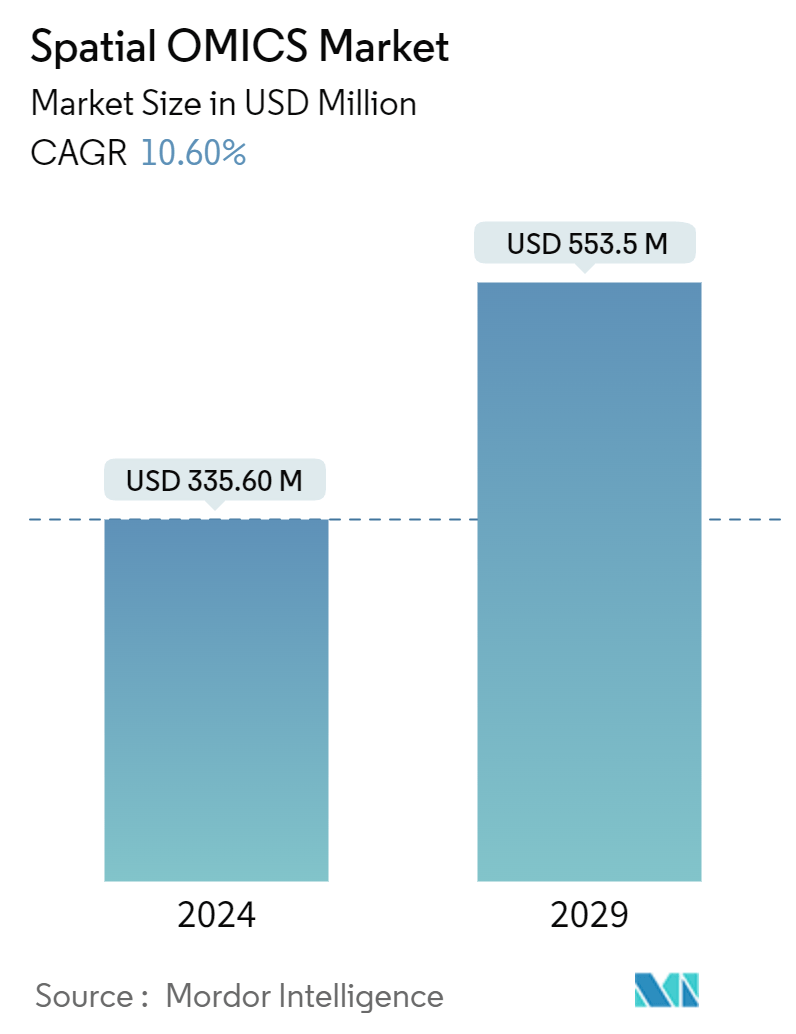Market Size of Spatial OMICS Industry

| Study Period | 2021 - 2029 |
| Market Size (2024) | USD 335.60 Million |
| Market Size (2029) | USD 553.5 Million |
| CAGR (2024 - 2029) | 10.60 % |
| Fastest Growing Market | Asia Pacific |
| Largest Market | North America |
| Market Concentration | High |
Major Players
*Disclaimer: Major Players sorted in no particular order |
Spatial OMICS Market Analysis
The Spatial OMICS Market size is estimated at USD 335.60 million in 2024, and is expected to reach USD 553.5 million by 2029, growing at a CAGR of 10.60% during the forecast period (2024-2029).
Major factors, including the rising incidence of cancer, genetic illnesses, and rare diseases, global advances in sequencing technologies, and increased financing for OMICS research drive the market.
The growing burden of cancer is expected to boost the spatial omics market as spatial omics techniques provide detailed information about the molecular and cellular characteristics of cancer and genetic diseases, including genetic mutations, protein expression patterns, and cellular interactions. For instance, according to the data updated by the Spanish Network of Cancer Registries (REDECAN) in January 2023, an estimated 279,260 new cases of cancer were expected to occur in Spain by the end of 2023, out of which 42,721 new cases of colorectal cancer, 31,282 cases of lung cancer, and 21,694 cases of urinary bladder cancer were expected to occur in Spain in 2023. Thus, the growing burden of cancer and the rising demand for precision medicine approaches, especially for genetic diseases, cancer, and rare diseases, is anticipated to create lucrative opportunities for market growth.
Moreover, increasing funding activities for spatial OMICS research is expected to contribute to the growth of the market as spatial OMICS funding contributes to the drug development pipeline by identifying potential drug targets, validating drug efficacy, and assessing drug distribution within tissues. For instance, in June 2023, Owkin Inc. contributed USD 50 million and joined forces with NanoString Technologies Inc. and research teams from European and American institutions and other organizations to use this technology for cutting-edge cancer research. Similarly, in November 2023, Stellaromics announced that the company had raised USD 25 million in a Series A financing round to advance 3D spatial multi-omic profiling. Such funding activities may lead to an increase in research and development activities and expand the application of OMICS for chronic diseases.
Further, technological advancement in spatial OMICS technology and product launches by the market players and engaged strategic activities such as partnerships and collaborations create lucrative opportunities for market growth. For instance, in November 2023, 10x Genomics and Owkin collaborated to add 10x Genomics single-cell technologies and spatial OMICS for the MOSAIC project. Similarly, in September 2023, Bruker reported advancements in instrumental methods, software, and consumables for 4D-Proteomics, 4D-Lipidomics MALDI HiPLEX-IHC spatial tissue proteomics, and 4D-Metabolomics.
Therefore, the growing burden of genetic diseases, cancer, and rare diseases underscores the importance of spatial OMICS technologies in advancing research, diagnostics, and therapeutic interventions, growing funding initiatives, and strategic activities by the market players, driving the demand and adoption of these innovative molecular analysis tools.
However, the high cost of OMICS instruments and data storage, stringent regulatory requirements, and standardization issues are expected to hamper the growth of the market over the forecast period.
Spatial OMICS Industry Segmentation
As per the scope of the report, Spatial OMICS encompasses technologies that merge molecular profiling with spatial information, facilitating the analysis of biological samples in their native spatial environment.
The spatial OMICS market is segmented by technology, products, workflow, sample, end user, application, and geography. By technology, the market is segmented into spatial transcriptomics, spatial genomics, and spatial proteomics. By products, the market is segmented into instruments, consumables, and software. By sample, the market is segmented into formalin-fixed paraffin-embedded (FFPE) and fresh frozen. By application, the market is segmented into diagnostics, translation research, drug discovery and development, single-cell analysis, cell biology, and others. By end user, the market is segmented into academic & translational research institutes, pharmaceutical & biotechnology companies, and others. By geography, the market is segmented into North America, Europe, Asia-Pacific, and the Rest of the World. The report also covers the estimated market sizes and trends for 17 countries across major regions globally. For each segment, the market sizing and forecasts were made on the basis of value (USD).
| By Technology | |
| Spatial Transcriptomics | |
| Spatial Genomics | |
| Spatial Proteomics |
| By Product | |
| Instruments | |
| Consumables | |
| Software |
| By Sample | |
| Formalin-Fixed Paraffin-Embedded (FFPE) | |
| Fresh Frozen |
| By Application | |
| Diagnostics | |
| Translation Research | |
| Drug Discovery and Development | |
| Single Cell Analysis | |
| Cell Biology | |
| Other |
| By End User | |
| Academic & Translational Research Institutes | |
| Pharmaceutical & Biotechnology Companies | |
| Others |
| Geography | ||||||||
| ||||||||
| ||||||||
| ||||||||
| Rest of the World |
Spatial OMICS Market Size Summary
The spatial OMICS market is poised for significant growth, driven by the increasing prevalence of cancer, genetic disorders, and rare diseases. Advances in sequencing technologies and heightened funding for OMICS research are key factors propelling the market forward. Spatial OMICS techniques offer in-depth insights into the molecular and cellular characteristics of diseases, making them invaluable for precision medicine. The market is further bolstered by strategic collaborations and technological advancements, such as those seen with companies like 10x Genomics and Owkin Inc., which are enhancing the capabilities and applications of spatial OMICS technologies. Despite challenges like high costs and regulatory hurdles, the market's trajectory remains positive, with ongoing innovations and partnerships expected to expand its reach and impact.
In North America, the spatial OMICS market is experiencing robust growth due to substantial investments from academic institutions, biotechnology firms, and pharmaceutical companies. The region's focus on precision diagnostics and drug development, coupled with the rising incidence of chronic diseases, is driving demand for spatial OMICS solutions. Collaborative efforts, such as those between Bio-Techne and Lunaphore, are facilitating advancements in technology and data standardization, further enhancing market penetration. The competitive landscape is marked by numerous players, including 10x Genomics and Bruker, who are actively engaging in innovation and product differentiation. These dynamics, along with strategic product launches and research initiatives, are expected to sustain the market's growth momentum over the forecast period.
Spatial OMICS Market Size - Table of Contents
-
1. MARKET DYNAMICS
-
1.1 Market Overview
-
1.2 Market Drivers
-
1.2.1 High Burden of Cancer and Genetic Diseases
-
1.2.2 Advancement in Omics Technologies and Increasing Demand for Personalized Medicine
-
1.2.3 Rising Government Initiatives and Funding Activities
-
-
1.3 Market Restraints
-
1.3.1 High Cost of Instruments and Data Storage
-
1.3.2 Complex Regulatory Requirement and Standardization Issues
-
-
1.4 Porter's Five Forces Analysis
-
1.4.1 Threat of New Entrants
-
1.4.2 Bargaining Power of Buyers/Consumers
-
1.4.3 Bargaining Power of Suppliers
-
1.4.4 Threat of Substitute Products
-
1.4.5 Intensity of Competitive Rivalry
-
-
-
2. MARKET SEGMENTATION (Market Size by Value - USD)
-
2.1 By Technology
-
2.1.1 Spatial Transcriptomics
-
2.1.2 Spatial Genomics
-
2.1.3 Spatial Proteomics
-
-
2.2 By Product
-
2.2.1 Instruments
-
2.2.2 Consumables
-
2.2.3 Software
-
-
2.3 By Sample
-
2.3.1 Formalin-Fixed Paraffin-Embedded (FFPE)
-
2.3.2 Fresh Frozen
-
-
2.4 By Application
-
2.4.1 Diagnostics
-
2.4.2 Translation Research
-
2.4.3 Drug Discovery and Development
-
2.4.4 Single Cell Analysis
-
2.4.5 Cell Biology
-
2.4.6 Other
-
-
2.5 By End User
-
2.5.1 Academic & Translational Research Institutes
-
2.5.2 Pharmaceutical & Biotechnology Companies
-
2.5.3 Others
-
-
2.6 Geography
-
2.6.1 North America
-
2.6.1.1 United States
-
2.6.1.2 Canada
-
2.6.1.3 Mexico
-
-
2.6.2 Europe
-
2.6.2.1 Germany
-
2.6.2.2 United Kingdom
-
2.6.2.3 France
-
2.6.2.4 Italy
-
2.6.2.5 Spain
-
2.6.2.6 Rest of Europe
-
-
2.6.3 Asia-Pacific
-
2.6.3.1 China
-
2.6.3.2 Japan
-
2.6.3.3 India
-
2.6.3.4 Australia
-
2.6.3.5 South Korea
-
2.6.3.6 Rest of Asia-Pacific
-
-
2.6.4 Rest of the World
-
-
Spatial OMICS Market Size FAQs
How big is the Spatial OMICS Market?
The Spatial OMICS Market size is expected to reach USD 335.60 million in 2024 and grow at a CAGR of 10.60% to reach USD 553.5 million by 2029.
What is the current Spatial OMICS Market size?
In 2024, the Spatial OMICS Market size is expected to reach USD 335.60 million.

